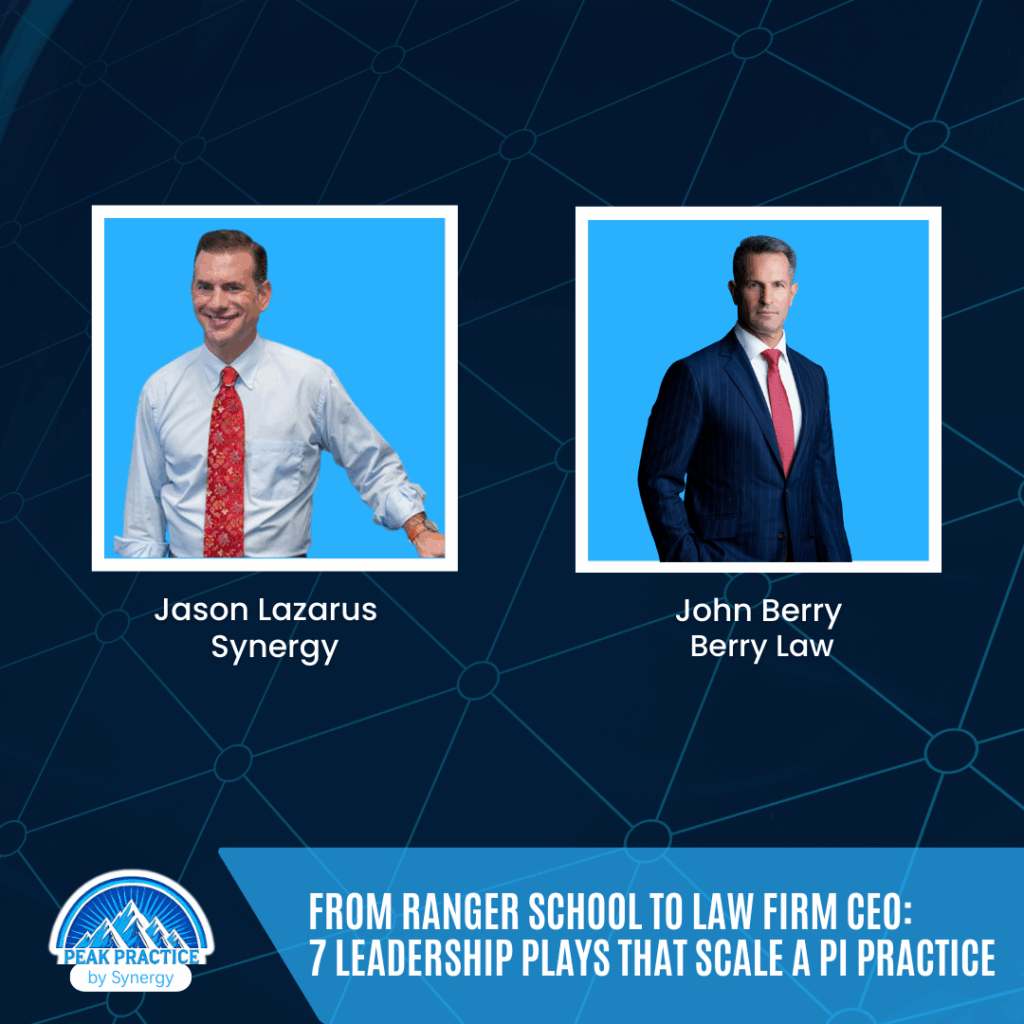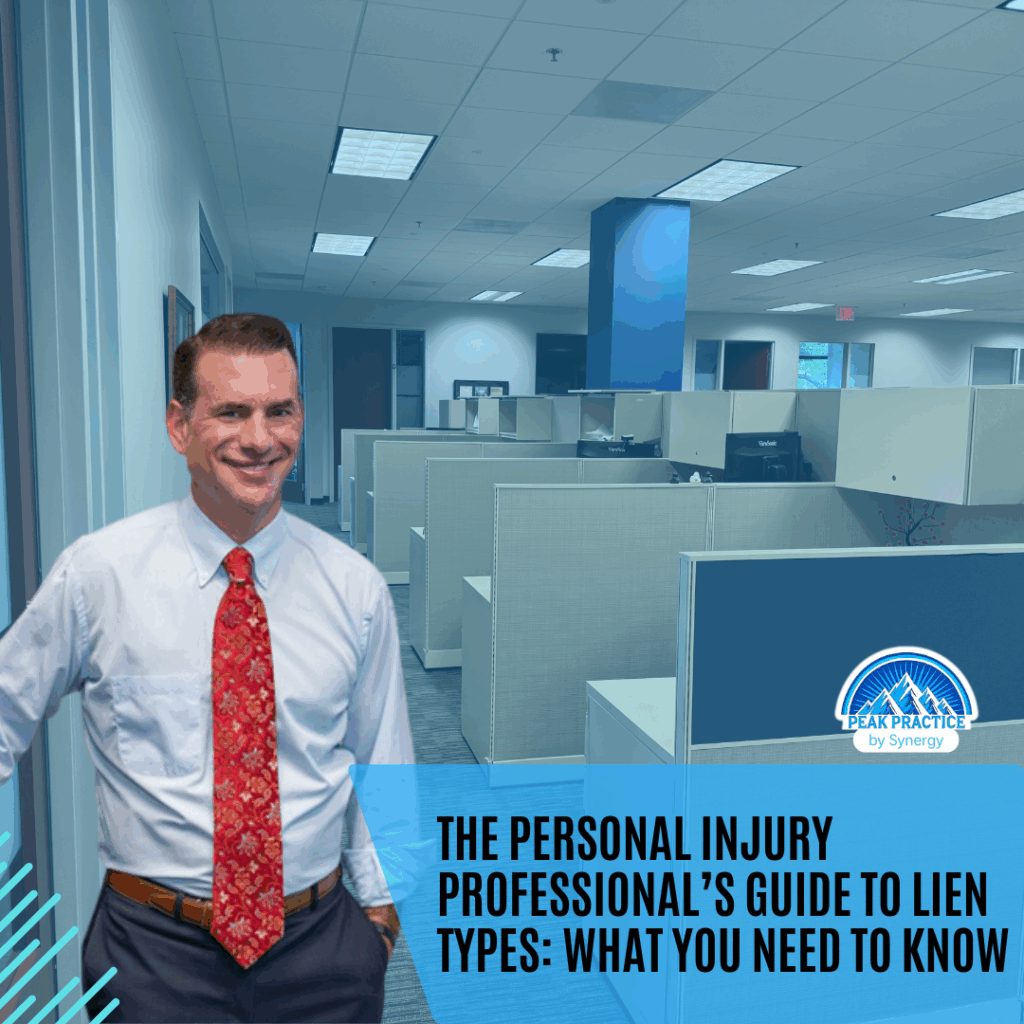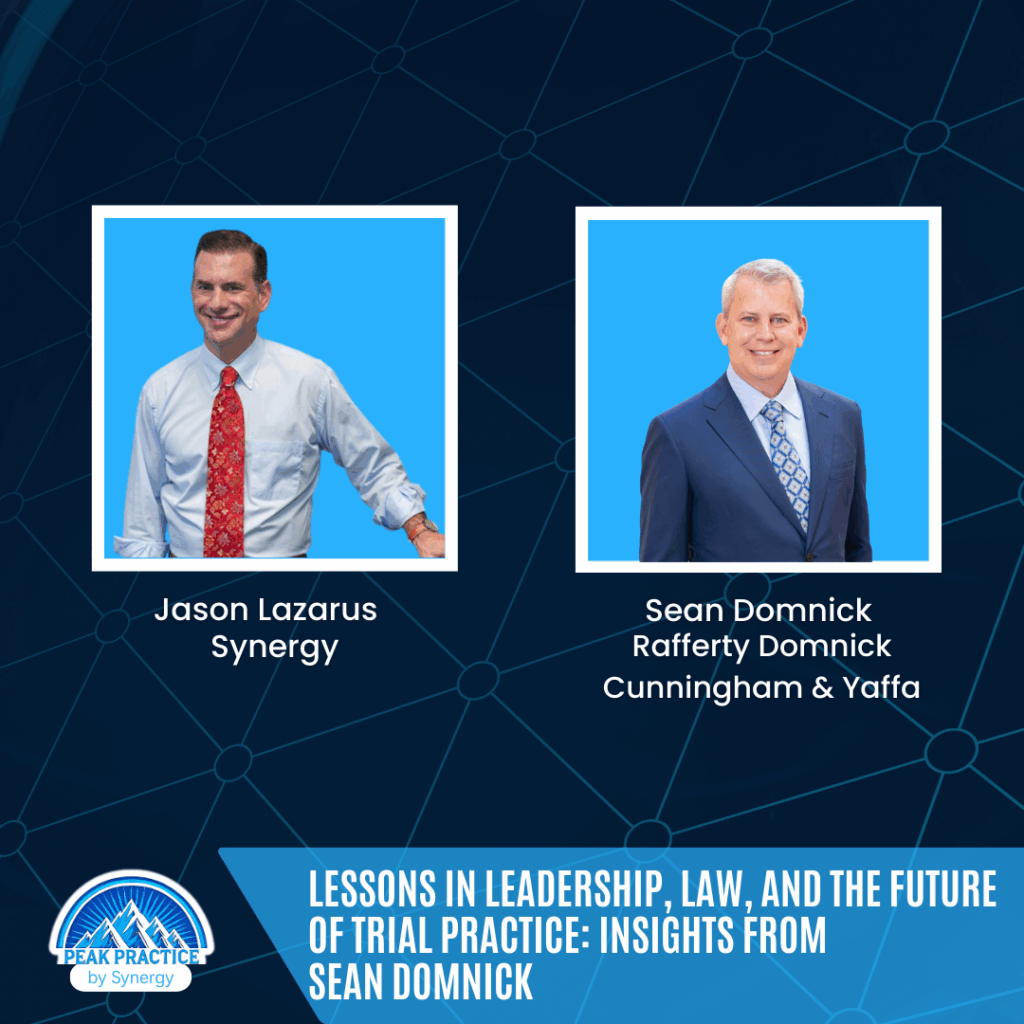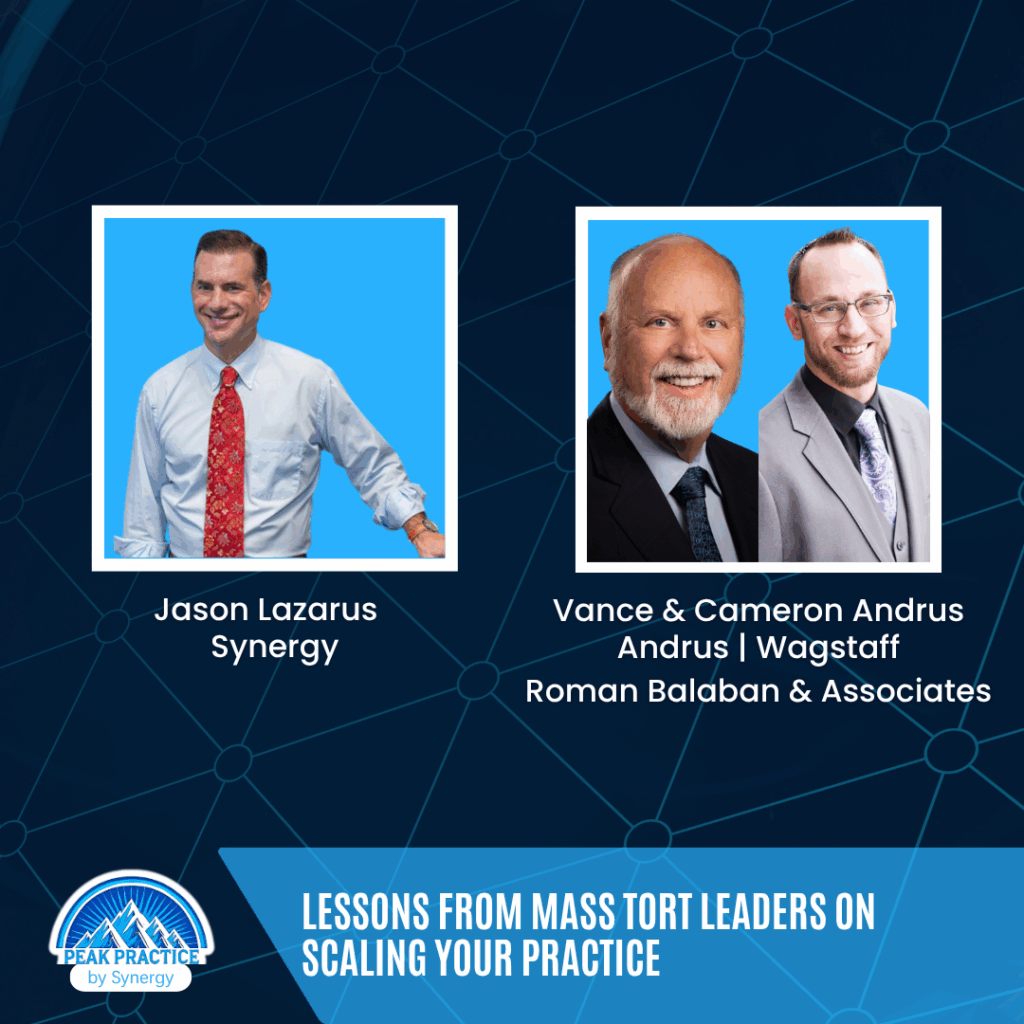PEAK PRACTICE
Peak Practice is a community that delivers expert industry insights on how to scale, streamline, and accelerate personal injury law practices. By providing knowledge and resources on law firm operations, marketing, and business growth, Peak helps personal injury attorneys gain a competitive edge. As the leader in lien resolution, Synergy partners with firms to eliminate settlement bottlenecks, optimize client outcomes, and drive greater profitability—so you can focus on securing justice. Join the community here and discover how partnering with Synergy helps you achieve Peak Practice.
Below are our Synergy InSights on all things related to Peak Practice.
When John S. Berry and I sat down for Trial Lawyer View, one moment hit me like a flash grenade: “As of last Friday, Berry Law has about 187 employees in 12 states.” That kind of growth doesn’t happen by accident. It happens because a leader owns the vision, builds the right infrastructure, and keeps lawyers focused on what actually moves cases and clients forward.
John’s journey from Ranger School to running a national veterans and injury firm offers a practical playbook for any trial lawyer who wants to grow without losing the soul of the practice. Here are seven leadership moves you can steal today.
🎯 Own the vision
In the old partner-driven model, everyone has a say and no one has a clear picture. John’s take is simple: one leader has to visualize the whole “battlefield,” see the obstacles, and align the team around a single direction. Otherwise, you’re staring at half the beach ball and missing what’s on the other side.
🏗️ Build “battalion” infrastructure
John organized his firm like an infantry battalion: dedicated leads for sales, marketing, IT, operations, finance, and HR whose job is to support the lawyers. That structure keeps legal strategy with the lawyers while specialists run the business functions at a high level.
⚖️ Keep lawyers in the strategy seat
“Officers plan and NCOs execute.” That military truth maps cleanly to plaintiff work. Senior trial lawyers set the strategy and carry the burden for the case; talented staff and associates execute so the lead lawyer doesn’t get lost in the weeds. When lawyers try to do everything, they miss the big picture that wins trials and drives results.
🏁 Decide faster than the next firm
Indecision kills momentum. John told a story about a 30-lawyer firm that spent six months arguing over carpet color while growth stalled. Leaders who make timely calls, even on small stuff, keep the organization focused on the mission, not the blinds.
🪖 Prepare like a Ranger, adapt like a CEO
Berry Law already had remote leadership muscle before COVID. When the world shifted, they had an “op plan” and moved the team remote overnight. That readiness mindset lets you respond fast and keep serving clients when conditions change.
📊 Measure what matters
Plenty of firms still skip the basics: KPIs, regular reviews, data-driven decisions. If you can’t see workload, utilization, and cash flow in near real time, you’re flying blind. That’s not a business; it’s a hope.
📈 Put results over reputation
This one’s worth taping to your monitor: “Don’t worry about your reputation, worry about your results.” Do right by the client, teach your team to do the same, and reputation follows. That’s how you grow sustainably in PI.
🧘♂️⚖️ Courtroom bonus: Presence beats bravado
The best trial lawyers aren’t loud; they’re locked in. John calls it “situational awareness.” Be the most prepared, most credible person in the room. Stay flexible because the story can shift in an instant. Preparation is the path to poise.
Quick wins you can implement this quarter
- Name your vision owner. If it’s you, say it out loud. If it’s not, pick them. Then document the next 3 firm priorities.
- Stand up a battalion-style org. Assign accountable leads for marketing, intake/sales, ops, finance, IT, and HR. Their job is serving the lawyers.
- Unburden your trial lawyers. Push non-lawyer tasks to trained staff. Keep your best lawyers on strategy, relationships, and high-value advocacy.
- Codify an “op plan” for disruption. If you had to go remote again tomorrow, what happens in 24 hours? Write it. Test it.
- Publish and review KPIs monthly. Intake-to-sign rates, cycle times, case value velocity, AR days. If it impacts clients, measure it.
- Coach presence. Trial skills training that prioritizes awareness and preparation beats “winging it” every time.
🌄 Why This Matters to the Peak Practice Community
John’s philosophies matter to the Peak Practice community because they translate growth into a disciplined, client-first operating system. A single owner of the vision, a battalion-style structure that supports lawyers, and a results-over-reputation mindset give firms clarity on who does what and why it matters. His focus on preparation, fast decision-making, and measurable KPIs helps trial teams keep their edge in the courtroom while the business runs with purpose. That approach aligns with Peak’s mission to help innovative PI firms scale, sharpen operations, and invest their time where it counts most. It also pairs naturally with Synergy’s role in removing lien and settlement bottlenecks so leaders can stay in the strategy seat. For attorneys who want to grow without losing their core, John’s playbook is a practical roadmap for building a durable, high-trust practice.
🎧 Listen to the full podcast conversation on Trial Lawyer View here: https://triallawyerview.com/podcast/john-berry/
🔗 Want more insights like this?
If you’re a personal injury lawyer ready to scale, streamline, and step into your role as CEO, let’s talk. Join the Peak Practice Community, and learn how Synergy can help you eliminate settlement bottlenecks, resolve complex liens, and maximize recoveries. Learn more here: https://partnerwithsynergy.com/peak-practice/
If you want to grow and scale your law firm more effectively, consider partnering with Synergy for lien resolution. Learn more at: https://partnerwithsynergy.com/liens/
In the high-stakes world of personal injury litigation, one word can quietly threaten your client’s net recovery and your firm’s efficiency: liens.
From government agencies to private insurers, everyone wants a piece of your client’s recovery. But not all liens are created equal. And if you don’t understand how to identify, analyze, and resolve them, you could cost your client thousands or expose your firm to malpractice risk.
In this Peak Practice Newsletter, we’re breaking down the essential lien types every legal professional should know. But first, let’s tackle the threshold issue of whether you are dealing with a lien, subrogation, reimbursement or just a debt.
🔍 Is it a lien, subrogation, reimbursement rights or just a debt?
In personal injury cases, a lien gives a health insurance plan or a hospital the ability to get paid from a personal injury recovery. A lien is different from a simple debt. A debt means someone is owed money, but a lien means they have a legal claim to specific funds, like the personal injury settlement.
There are also other types of claims that could be asserted. Subrogation arises when an insurance company steps into the shoes of your client and claims the right to recover from the person who caused the injury. Reimbursement rights, sometimes called an “equitable lien by agreement,” are based on a contract with a health insurance plan.
Understanding these differences matters. Not every claim to your client’s settlement is enforceable like a perfected lien and knowing the difference can help you protect your client’s bottom line. If there is a lien or reimbursement right, here is some basic guidance and explanation about the most frequently encountered types in a personal injury settlement.
⚖️ The 7 Major Types of Health Insurance Liens/Reimbursement Claims You Are Likely to Encounter
1. Medicare (Parts A & B) Conditional Payments
These arise when Medicare pays for injury-related care before settlement. Under the Medicare Secondary Payer Act, Medicare must be reimbursed. The resolution process is tedious and unforgiving.
👉 Why it matters: Failure to pay Medicare’s final demand within 60 days can result in unwanted government action and personal liability for the attorney.
2. Medicare Advantage (Part C) Liens
These are administered by private insurers and often are missed or overlooked. Unlike traditional Medicare, they don’t always follow transparent government protocols. Private recovery vendors like Rawlings or Optum aggressively pursues these claims.
👉 Pro tip: These must be resolved separately from traditional Medicare Conditional Payments. Don’t confuse the two. And be aware that if you miss one, Medicare Advantage plans have become quite aggressive in trying to recover double the lien amount under the MSP double damages provision.
3. Medicaid Liens
State-run Medicaid programs assert liens based on their own rules. The variability can be dizzying as what applies in Florida doesn’t in California.
👉 Why it’s risky: Failing to follow state-specific procedures can derail disbursement and violate statutory requirements. Remember though, Ahlborn (US Supreme Court decision) does provide a reduction formula that can be argued in nearly every state.
4. ERISA Liens
Employer-sponsored health plans, especially self-funded ERISA plans, are powerful lienholders. Thanks to SCOTUS rulings like Sereboff and McCutchen, plan language rules the day.
👉 Red flag: If the plan disclaims the “made whole” and “common fund” doctrines, equitable defenses may be lost. But there are typically leverage points that can be used to try and secure a reduction.
5. FEHBA and Military Liens
Federal employee and military health plans, including TRICARE, assert liens under federal statutes. They’re often strict, opaque, and slow to compromise.
👉 Pro insight: You must negotiate with federal recovery contractors directly, timing and communication are key.
6. Private Health Insurance / Subrogation Claims
These range from group plans to fully insured policies. Resolution depends on policy language and, often, the aggressiveness of recovery vendors.
👉 Strategy tip: Always request plan documents and scrutinize for enforceability under applicable state law.
7. Hospital and Provider Liens
Hospitals may file statutory liens for unpaid bills. These are often inflated and must be scrutinized for reasonable value of services, not full billed charges.
👉 Avoid this pitfall: Failing to reduce to reasonable cost can be very costly for your client.
🧠 Why Personal Injury Professionals Must Understand the Various Lien Types
Each lien type comes with its own procedural landmines. Missteps can:
- Delay case closure
- Jeopardize your client’s recovery
- Trigger personal liability
- Lead to malpractice exposure
Understanding lien nuances isn’t optional, it’s a professional obligation. It’s also an opportunity: effective lien resolution can maximize your client’s net and enhance your firm’s Google reviews.
🔧 What Can You Do?
If this feels overwhelming, you’re not alone. Synergy has spent decades helping firms like yours ethically and efficiently resolve complex lien issues. Our team knows the playbook recovery contractors use and how to beat them at their own game.
🔗 Want more insights like this?
If you’re a personal injury lawyer ready to scale, streamline, and move your practice forward exponentially, let’s talk. Join the Peak Practice Community, and learn how synergy. can help you eliminate settlement bottlenecks, resolve complex liens, and maximize recoveries. Learn more here: https://partnerwithsynergy.com/peak-practice/
If you want to grow and scale your law firm more effectively, consider partnering with Synergy for lien resolution. Learn more at: https://partnerwithsynergy.com/liens/
What does it take to lead trial lawyers across the country, balance the demands of a very busy medical mal practice, and confront emerging challenges like artificial intelligence and attacks on the rule of law?
In a recent episode of the Trial Lawyer View by Synergy podcast, I sat down with Sean Domnick of Rafferty Domnick Cunningham & Yaffa, past president of the American Association for Justice (AAJ) and one of the nation’s most respected trial lawyers, for a conversation that every attorney focused on growth and impact should hear.
🤝👥The Power of Relationships in Leadership
When Sean reflected on his time as AAJ president, one theme stood out: relationships. He described how trial lawyers, despite differing opinions, rallied around the importance of being heard and respected. The lesson applies as much inside a law firm as it does in the courtroom: the ability to build consensus, unify strong personalities, and move in one direction is what defines real leadership.
As Sean put it, trial work isn’t just about winning one case, it’s about cases that become causes, transforming single outcomes into broader change. For firms seeking to scale, that same mindset of turning challenges into opportunities for lasting impact is essential.
⚖️🤖Confronting Today’s Challenges: AI and the Rule of Law
We also tackled issues shaping the future of the profession. Sean emphasized that artificial intelligence is no longer a distant concept; it’s here. The AAJ even created a special committee to explore how AI can support practices while safeguarding against risks.
Equally pressing is the erosion of the rule of law. From judicial independence to the enforcement of rulings, trial lawyers are seeing threats that strike at the heart of democracy. Sean underscored the duty of lawyers to stand up, not just for their clients, but for the system itself because without the rule of law, the practice of law cannot exist.
🌄 Why This Matters to the Peak Practice Community
For the Peak Practice community, conversations like this matter because Sean’s perspective is both inspiring and practical. Growth isn’t just about more cases or bigger verdicts. It’s about:
- Building teams that align around a shared mission.
- Embracing new technology with a critical but open mind.
- Standing firm on values that sustain not only your practice, but the profession itself.
🎧 Listen to the full podcast conversation on Trial Lawyer View here: https://triallawyerview.com/podcast/sean-domnick/
🔗 Want more insights like this?
If you’re a personal injury lawyer ready to scale, streamline, and step into your role as CEO, let’s talk. Join the Peak Practice Community, and learn how synergy. can help you eliminate settlement bottlenecks, resolve complex liens, and maximize recoveries. Learn more here: https://partnerwithsynergy.com/peak-practice/
If you want to grow and scale your law firm more effectively, consider partnering with Synergy for lien resolution. Learn more at: https://partnerwithsynergy.com/liens/
What happens when a drug designed to save lives ends up changing them forever for the worse? That question is at the center of a growing storm surrounding Ozempic and similar GLP-1 medications that have exploded in popularity for weight loss.
In a recent Trial Lawyer View by Synergy podcast episode, I sat down with mass tort veteran Michael Lynch of The Michael Brady Lynch Firm , who’s spent the last 20+ years holding pharmaceutical companies accountable for their missteps. From Baycol to Ozempic, Lynch has seen firsthand how billion-dollar drugs can quickly turn into billion-dollar liabilities and why trial lawyers are often the only line of defense for injured patients.
This episode is a masterclass in what it takes to anticipate, prepare for, and prosecute mass torts that are just beginning to unfold.
🚨 The Ozempic Lawsuits: What You Should Be Watching
Originally approved as a diabetes drug, Ozempic’s off-label popularity for weight loss has created a booming market and a rising tide of serious side effects.
Lynch shared what he’s already seeing on the front lines of this litigation:
- Gastroparesis (paralyzed stomach): A potentially life-threatening condition requiring surgery. Many clients don’t even know this term until they end up in the ER.
- Blindness: An emerging second wave of cases that may soon eclipse the initial round of GI injuries.
Despite the mounting evidence, most consumers and many doctors aren’t aware of the risks. According to Lynch, “What’s going to change everything is when someone famous experiences a serious side effect. That’s when public awareness and regulation catch up.”
🔍 The Anatomy of a Mass Tort That Moves the Needle
What makes a drug litigation case viable? Lynch laid out the three pillars that help trial lawyers vet emerging mass torts:
- Signature injury – Clear and traceable side effects, like rhabdomyolysis in Baycol or gastroparesis in Ozempic.
- Bad actor behavior – Manipulated studies, ghostwritten medical journals, or regulatory shortcuts.
- Market scale – Widespread use and real human impact, which multiplies the legal and ethical urgency.
For those newer to mass tort work, Lynch’s story about getting his start with Baycol was both inspiring and strategic. It was a “perfect entry point,” he says a drug with a strong safety perception, obvious harm, and a quick FDA withdrawal. That combination allowed him to learn fast, build a reputation, and develop lasting relationships with other leading lawyers in the space.
💡 Why Trial Lawyers Should Be Paying Attention
Mass torts aren’t just about individual justice. They shape public health policy, expose systemic flaws, and deter corporate misconduct. As Lynch put it: “This is patient care on a wide scale. It’s the drugs your parents, your kids, your friends are using. These cases can literally change how medicine is practiced.”
If you’re a PI lawyer looking to grow your practice, mass torts are no longer a niche. They are a front line in the evolving landscape of personal injury law and a major opportunity for firms ready to scale, specialize, or partner.
🌄 Why This Matters to the Peak Practice Community
For the Peak Practice community, conversations like this matter because they reveal how legal insight and early action can shape the trajectory of mass tort litigation. Hearing Michael Lynch break down the risks of drugs like Ozempic—and how to identify viable cases before they dominate headlines—gives trial lawyers a tactical edge. The takeaways—recognizing signature injuries, understanding drug approval pitfalls, and anticipating shifts in public perception—equip firms to act with precision, protect clients, and build stronger cases. This is the kind of foresight that helps firms grow their impact while staying ahead of emerging litigation trends.
🎧 Listen to the full podcast conversation on Trial Lawyer View here: https://triallawyerview.com/podcast/michael-lynch/
🔗 Want more insights like this?
If you’re a personal injury lawyer ready to scale, streamline, and step into your role as CEO, let’s talk. Join the Peak Practice Community, and learn how synergy. can help you eliminate settlement bottlenecks, resolve complex liens, and maximize recoveries. Learn more here: https://partnerwithsynergy.com/peak-practice/
If you want to grow and scale your law firm more effectively, consider partnering with Synergy for lien resolution. Learn more at: https://partnerwithsynergy.com/liens/
When was the last time you calculated how much time your team spends chasing medical records? If you’re handling mass torts or high-volume single-event cases, you already know the answer, too much.
In a recent Trial Lawyer View by Synergy podcast conversation, I sat down with Daniel Miner of Angeion Group to talk about a challenge that plagues even the most sophisticated firms, validating cases quickly and thoroughly while keeping clients engaged through the long haul. The solutions his team is delivering could change how trial lawyers think about case development.
🔍 The Hidden Bottleneck in Mass Torts
Medical records are the backbone of any valid claim. But retrieving them is rarely straightforward. Facilities reject requests for everything from name changes to incorrect date ranges. Your staff ends up chasing both the providers and the clients, burning hours that could be spent building winning case strategy.
Angeion is tackling this head-on with a blend of AI, nursing expertise, and a nationwide client engagement operation. They start with electronic health record networks, pull everything available, then validate with trained nurses. The result? You get the right records, tied directly to the right claimant in your CMS, without the operational drag.
🚀 Why This Matters for Growth-Minded Firms
Scaling a trial practice isn’t just about signing more clients, it’s about moving them from intake to resolution efficiently. Every time your paralegals stop to resend a HIPAA form or confirm a doctor’s visit from three years ago, momentum slows. Miner’s approach keeps that process moving, letting your team focus on the advocacy that wins.
Angeion also solves a problem many firms overlook: client fallout. Mass torts can take years, and frustrated clients can disappear. Proactive engagement throughout the litigation keeps them connected, informed, and ready when it’s time to sign settlement documents.
💡 The Takeaway for Innovative Trial Lawyers
If you’re serious about growth, think beyond marketing and intake. Look at your operational bottlenecks. Ask yourself:
- How much of our team’s time is spent on tasks that don’t require legal expertise?
- Do we know which cases will hold up at resolution — before investing years into them?
- Are we keeping clients engaged from day one to settlement?
The firms that can answer those questions with confidence will be the ones that scale profitably in the next decade.
🌄 Why This Matters to the Peak Practice Community
For the Peak Practice community, conversations like this matter because they show how operational excellence directly fuels case outcomes and firm growth. Hearing how Dan Miner and the Angeion team tackle the bottlenecks of medical record retrieval, case validation, and client engagement gives trial lawyers practical ways to free up their teams for higher-value work. The lessons — leveraging technology for accuracy, combining it with skilled human review, and maintaining strong client relationships over long litigation timelines — are exactly what help firms scale without losing their personal touch.
🎧 Listen to the full podcast conversation on Trial Lawyer View here: https://triallawyerview.com/podcast/dan-miner/
🔗 Want more insights like this? If you’re a personal injury lawyer ready to scale, streamline, and step into your role as CEO, let’s talk. Join the Peak Practice Community, and learn how synergy. can help you eliminate settlement bottlenecks, resolve complex liens, and maximize recoveries. Learn more here: https://partnerwithsynergy.com/peak-practice/
If you want to grow and scale your law firm more effectively, consider partnering with Synergy for lien resolution. Learn more at: https://partnerwithsynergy.com/liens/
When you hear “mass tort,” you probably think complexity, coordination, and chaos. But what if it’s also the future of scalable legal practice?
On a recent episode of the Trial Lawyer View by Synergy podcast, I sat down with Vance Andrus—a seasoned litigator and architect of some of the most impactful mass tort cases in the country. We were also joined by Vance’s son, Cameron Andrus who is the mass tort manager for Roman Balaban and Associates. Together, we unpacked not just the litigation mechanics of MDLs (multi-district litigation), but what it really takes to lead in that space.
Let me tell you—this wasn’t your typical war story.
🎯 The Untold Challenge of MDLs: Leadership Isn’t Just Assigned. It’s Earned.
Vance put it bluntly: “In a single event, you’re the leader. In mass torts, you have to earn the right to lead thousands.”
The behind-the-scenes politics of MDL leadership can be brutal, elections, personalities, and the need to prove you can manage not just discovery and strategy, but human relationships. And for those already managing thousands of clients back at the firm, this can mean choosing your lane: be the MDL leader, or run the firm. Rarely both.
If you’re trying to grow, here’s the lesson: real scale comes from real delegation. And it starts by empowering people, not just assigning them tasks.
👥 Your Clients Aren’t Inventory. They’re Populations.
Cameron dropped a truth that should hit home for any lawyer looking to scale ethically: “Clients aren’t inventory. They’re people. Populations. And they deserve to be treated that way.”
He outlined a practical system that any firm can implement: a centralized communication rhythm. Send monthly updates to everyone, even if nothing has changed. Call every client quarterly. Ask how their family’s doing. Keep their email current. Simple? Yes. But harder in practice.
If you’re scaling mass tort or simply trying to manage large caseloads better, this approach is a masterclass in operational empathy.
⚖️ How Do You Deal with Problematic MDLs?
When an MDL is a problem, it’s not always the defense—or the facts. It can be a judge who doesn’t understand aggregation. It can be discovery processes that spiral out of control. Or worse, internal misalignment between MDL and state court strategies.
Cameron offered tactical advice: coordinate early. If you know your MDL is going to be tough, explore state court pathways. But don’t go rogue. Loop in leadership, coordinate terms, and negotiate information sharing from day one.
The best results come when there’s alignment across jurisdictions and leadership—not just litigation firepower.
Key Takeaways for Growth-Minded Firms
· Clients need to feel seen even at scale. Thoughtful communication systems are your edge.
· Real leadership in mass torts starts with humility and strategy, not hunger for headlines.
· Your firm’s scalability hinges on who you empower and how much authority they’re actually given.
🌄 Why This Matters to the Peak Practice Community
For the Peak Practice community, conversations like this matter because they bridge the gap between courtroom strategy and business growth. Understanding how leaders like Vance and Cameron Andrus navigate the complexity of MDLs gives trial lawyers actionable insight into scaling their practices without sacrificing client care. These lessons: delegating authority, treating clients as people not case numbers, and building systems that withstand high-volume litigation are exactly what allow firms to grow sustainably. By learning from top practitioners, our community gains the tools to operate more efficiently, serve clients better, and position their firms as leaders in the evolving personal injury landscape.
🔗 Ready to Think Differently About Your Practice?
🎧 Listen to the full conversation on Trial Lawyer View here: https://triallawyerview.com/podcast/vance-cameron-andrus/
📩 Subscribe to the Peak Practice newsletter for more content like this
🗣️ Join the conversation in our growing LinkedIn community
🔗 Want more insights like this?
If you’re a personal injury lawyer ready to scale, streamline, and step into your role as CEO, let’s talk. Join the Peak Practice Community, and learn how Synergy can help you eliminate settlement bottlenecks, resolve complex liens, and maximize recoveries. Learn more here: https://partnerwithsynergy.com/peak-practice/
If you want to grow and scale your law firm more effectively, consider partnering with Synergy for lien resolution. Learn more at: https://partnerwithsynergy.com/liens/
BLOGS
READY TO SCHEDULE A CONSULTATION?
The Synergy team will work diligently to ensure your case gets the attention it deserves. Contact one of our legal experts and get a professional review of your case today.






